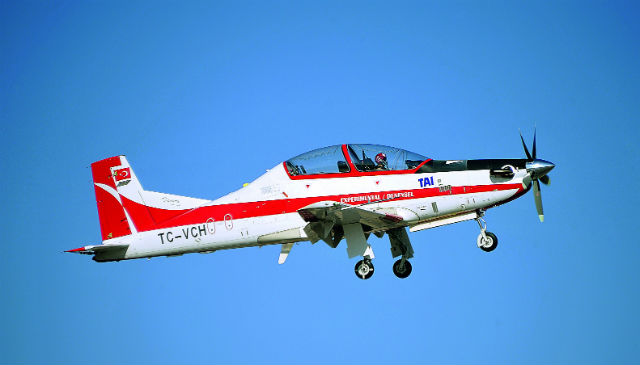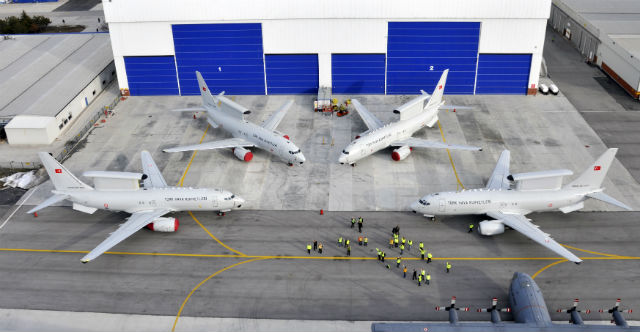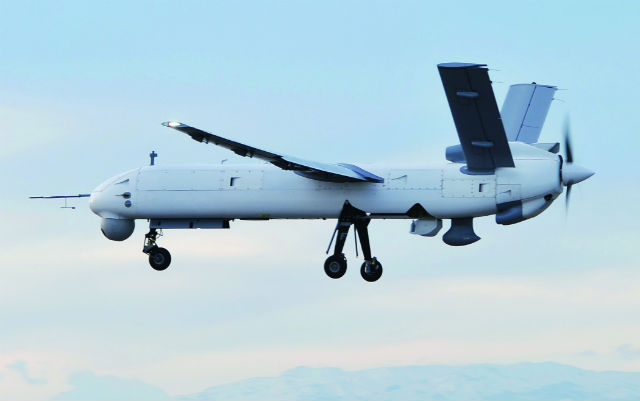Just over 40 years ago, the government in Ankara embarked on a venture that was intended to transform the Turkish military from being largely dependent on foreign-sourced weapon systems by creating a capable national defence industry.
Since being formed in June 1973 with the responsibility of becoming the nation’s sector champion, the now Turkish Aerospace Industries (TAI) has swiftly grown its capabilities.
The process began with assembling some of the Turkish air force’s Lockheed Martin F-16C/Ds; an activity which ran between 1986 and 2012. The company’s involvement with the fighter has since continued, with the last of 163 upgraded examples (below) having been returned to the service on 10 April.

Turkish Aerospace Industries
TAI has also previously provided avionics enhancements and structural upgrades for the type for the air forces of Jordan and Pakistan, and believes that additional modifications could be made for its domestic customer and other users. “There is strong competition in the F-16 modernisation market, but we believe that there may be some [further] opportunities,” it says.
Other examples of local assembly have included the Airbus CN235 medium transport, and the Airbus Helicopters AS532 utility helicopters which were acquired for the Turkish armed forces.
More recently, the company has gone further, through its development and production of the AgustaWestland AW129 Mangusta fuselage-derived T129 ATAK platform. Eight aircraft from an initial batch of nine A-model attack helicopters have been handed over to the Turkish army, and the first examples in a more capable T129B configuration will be transferred later this year. A firm order has been placed for 59 of the type, with Ankara also having options on a further 32.
Adapted to meet the requirements laid down by Turkey’s SSM defence procurement body, the T129 has gained numerous Turkish-developed systems and weapons, plus new engines, transmission and tail rotor.

BillyPix
“[Roketsan] Mizrak anti-tank missiles and Cirit guided rockets are already integrated onto the T129, and qualification processes regarding those weapons are successfully ongoing,” says TAI.
The company is already pushing to secure export orders, and refers to “a strong international interest from the Middle East, Gulf region and Asia”. It has already exhibited the T129 at major air shows in Bahrain, Germany and the UK, and will be taking it to Paris in June. Poland is a key sales target this year, with a need to replace its Mil Mi-24s.
“We believe that the T129 ATAK is a perfect fit for Poland’s requirements in terms of its unique capabilities and performance parameters,” says the company, which will display it at the Radom air show in August and the MSPO exhibition in Kielce the following month.
Meanwhile, the manufacturer is making preparations to begin assembling a tailored T-70 variant of Sikorsky’s S-70 Black Hawk, as part of a 109-aircraft programme for the Turkish armed forces, police and forest service. This will also involve domestic engine producer TEI, avionics supplier Aselsan and gearbox provider Alp Aviation. With its part of the contract to come into effect later this year, TAI expects to hand over its first T-70s in 2020. It will promote the variant to potential buyers in areas like the Middle East, Gulf region and Asia.
At the same time, it is moving ahead with an ambitious project to produce an indigenous light utility helicopter in the 5t weight class, having started study work in June 2013.
The twin-engined design will be adapted for both military and civilian applications. TAI has 250 engineers working on the programme, which is now in its system requirements review phase, and has established a new rotary-wing technology centre, to foster co-operation with small and medium-sized enterprises and universities.
“There is already a potential market for up to 400 helicopters in Turkey, and we believe our indigenous light utility helicopter will have a strong global market share,” it says.

Turkish Aerospace Industries
Its new rotorcraft will follow the Hurkus fixed-wing basic trainer out of development, with certification for the latter being sought from the European Aviation Safety Agency.
So far, a pair of Hurkus A trainers have completed more than 165 flights. “By the end of this year, we are planning to make the final flight tests with the EASA pilot to complete the flight test phase of the certification process,” the company says. Stress testing of the design has already concluded, and fatigue testing is about to start. An initial 15 aircraft have been ordered for the Turkish air force in a B-model configuration, with deliveries to commence during 2018.
“In the near future, Hurkus will be sold to countries requiring a modern and advanced trainer aircraft, and the reconnaissance/surveillance variant supported with weapon systems,” TAI believes.
Other current fixed-wing activities include an extensive avionics modernisation being made on the Turkish air force’s Lockheed C-130 tactical transports, with a first completed example having been returned to use.
TAI describes itself as being a “cradle-to-grave” industrial partner on the Airbus A400M, “in charge of challenging components from the centre-forward fuselage to emergency and paratroop doors, ailerons and spoilers to water/waste systems”. Turkey has introduced its first two of 10 of the new-generation type to date.
Another task has been the in-country conversion of three of the Turkish air force’s four Boeing 737 airborne early warning and control system aircraft.

Turkish Aerospace Industries
Much current work and emphasis is placed on TAI’s involvement in the Lockheed F-35 programme, which includes being a single or second-source supplier on multiple components, including the stealthy type’s centre fuselage, composite engine inlet ducts and metallic subassemblies. It also expects to be involved in providing in-service support for the 100 conventional take-off and landing F-35As to operated by the Turkish air force – the first six are on order – and also for some other Joint Strike Fighter users in Europe.
“In addition to the revenue expected for the programme, the privilege and prestige of being an important partner in the programme are also considered to be important,” the company says.
Such experiences gained since the outset of the current TAI’s journey since it was emerged from the former Turkish Aircraft Industries in 1984 will be of value as Turkey pursues its planned indigenous TFX fighter and TX trainer projects, which should deliver replacements for its current F-16 and Northrop T-38 fleets. But for now, the contractor declines to detail its activities linked to both efforts.
Meanwhile, next year will see the first delivery of an Anka unmanned air vehicle to the Turkish air force. A baseline A-model version has already completed qualification testing with the SSM, and an enhanced version of the unarmed type is the subject of a 10-unit launch order. A new Anka B variant also got airborne for the first time on 30 January (below).

Turkish Aerospace Industries
“We have discussed Anka exports with several countries in the past, and are discussing with some others as of today,” says TAI. “We believe the first international sale should be expected soon.”
Other UAV activities being pursued by the company include a four-year project to develop and test an unmanned rotorcraft for operation from naval vessels.
Almost 30 years after it handed over its first locally-assembled F-16, TAI has achieved its ambition of becoming a “world brand aerospace company”. This label will become more firmly attached once it has secured its first export deals with products like the T129, Hurkus and Anka.
Source: Flight International























